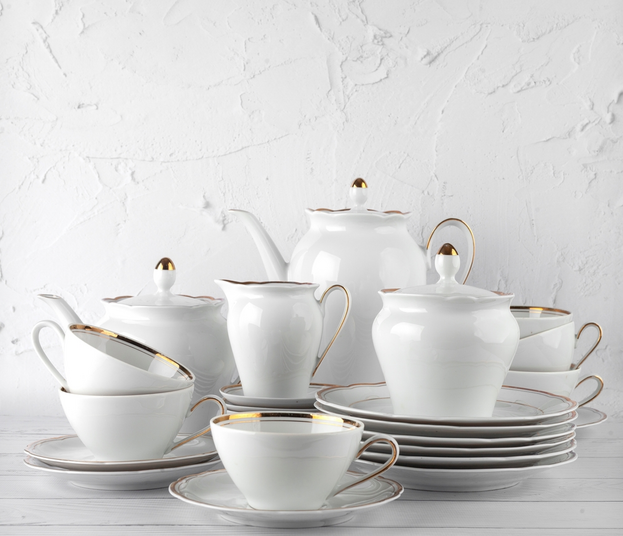You can never miss two things at a wedding reception; seats and tabletop ware. When it comes to crockery and cutlery, there are several terms that you might come across, and sometimes even used interchangeably, which can prove quite confusing.
For your big day, it is important to understand the key differences between the various crockery, especially if you want to have a hands-on approach. Each material has unique qualities, features, price points, and shortcomings.
This guide will highlight the main differences between China and Dinnerware, including care tips. This information is handy when selecting distinctive tabletop ware for your big day. Let’s get right into it, shall we?
What is China?
China is crockery made from clay, kaolin, feldspar, and quartz. This combination is then fired up in a kiln to create intricate, beautiful crockery designs. The term China is used generically to describe high-quality dishes reserved for use during special occasions.
What is Dinnerware?
Dinnerware is a broad definition of plates, dishes, serving bowls, platters, etc., used for serving and eating meals. Because of its broad definition, dinnerware often includes China as a subset.
There are several other types of dinnerware, including melamine, earthenware, stoneware, etc., which we will look into later on. Since there are hundreds of different types of dinnerware to choose from, we will look at some of the most elegant options hallmarked by their key features..
History of Chinaware
Chinaware originated in China, during the early 8th Century, during the Han and Tang Dynasties (618-907). This era was the golden age in which beautiful art and culture flourished. The arts flourished in specific areas of China, including Dehua in Fujihan, Jingdezhen in Jiangxi, Liling in Hunan, Shiwan in Guangdong, Tangshan in Hebei, and Zibo in Shandong, etc.
Types of China
Many people assume that all China refers to all fancy dishes and there’s no distinguishing between them, but this is far from the truth. There are different types of China dishes, each with its distinct qualities and features, that can be used to make your big day extra special. Let’s quickly take a look at different types of China.
Fine China
These crockeries are made from fine-particle clay combined with feldspar, kaolin, and quartz, fired up at high temperatures in a kiln. This results in extremely durable and nonporous dinnerware. Making fine China allows the wares to be more delicately constructed with a heavier body and a smooth, white, and lustrous appearance. Making fine China also allows shaped details to be incorporated into the body’s design.
Fine China is usually microwave, oven, and dishwasher safe unless indicated otherwise by the manufacturer. If the dishes have a gold, silver, or platinum border, then it’s not advisable to microwave them. Moreover, you shouldn’t use lemon or citrus-scented dish soap on them since they could damage the metal accents. Many people handwash their metal-accented fine China dishes. Fine China can create an upscale and refined look for your reception on your big day.
Bone China
Bone China is made from feldspar, ball clay, quartz, kaolin, and bone ash from farm animals, ground into a fine powder or ash. This mixture is then heated at a relatively lower temperature than fine china. This results in lightweight and delicate feeling table wares with a translucent milky appearance. Although bone China looks and feels more fragile, it’s the strongest and most durable. Most bone China contains between 25 and 45 percent of bone ash in the mixture.

Like fine China, bone China is also typically microwave, oven, and dishwasher safe unless the manufacturer indicates it isn’t. If it has metal banding, then you shouldn’t put them in a microwave or oven. Bone China has glazes that protect it from chipping and scratching; its refined look makes it a great pick for luxurious events.
Types of Dinnerware
As mentioned earlier, dinnerware is usually a blanket term for different crockeries. There are different types of dinnerware, each made from different materials and with their unique features. Let’s take a quick look at them.
Earthenware
Earthenware is ceramic that has been glazed and fired up and is usually less expensive than other types of dinnerware. It has a thick, heavy, and rustic look and feel. However, it is prone to chipping and is less durable and strong than other types of dinnerware. Earthenware is best known for its hand-painted designs.
The drawback of earthenware is that it’s often porous and prone to staining and absorbing liquid. Therefore, you must avoid submerging earthenware in water for an extended duration. Most glazed earthenware is microwave, oven, and dishwasher safe, but it’s wise to double-check with the manufacturers first.
Stoneware
Stoneware is also a type of ceramic that has been glazed and fired up. Stoneware is more durable than earthenware because the clay is heated at a higher temperature. Stoneware also has vitreous (glass) material added to it for more durability. The body of stoneware is typically more opaque and thicker than more refined materials like porcelain and China. Stoneware can be finished with various glaze textures such as satin, matte, or shiny.
Stoneware is typically used in casual, everyday place settings. However, they can also be used for special occasions such as weddings. Most superior quality stoneware is very versatile in terms of use and quite easy to maintain. However, it is important to note that stoneware shouldn’t be exposed to sudden or extreme temperature changes.
Melamine
Melamine is a lightweight plastic material with a sturdy, inflexible feel and a glossy finish. If you’re looking for unbreakable plates for your big day, then melamine is the way to go. Melamine is virtually indestructible and is ideal for children and outdoor use. Besides being a safe choice to avoid damage, melamine is also BPA-Free. If you are having an outdoor wedding or want dishes that the little ones can safely use, then you can consider melamine.
Vitrified Glass
Vitrified glass is usually opaque and created by being heated to an ultra-high temperature, so it’s non-porous and extremely durable. High-quality vitrified glass is virtually indestructible and will not break or chip even when dropped onto a hard floor. The unique look brings out a classy feel for table tops and speaks out luxe events. In addition, vitrified glass is safe for use in dishwashers and microwaves.
Porcelain

Although most people usually use China and porcelain interchangeably to describe dinnerware, there is a difference between the two. Both are made from the same materials, but their countries of origin and process of making are slightly different. Porcelain is fired at a higher temperature than fine China to make it more durable.
Porcelain has European origins, and the word is derived from the Latin word “porcella,” which means seashell. In terms of appearance, porcelain, and China are almost indistinguishable in their glazed form. Unglazed porcelain is known as bisque or biscuit, but it’s too porous in this form, so it isn’t used for tableware. Porcelain is also not as expensive as traditional China and bone China dishes. For an exquisite look, porcelain can perfectly fit your big day.
Choosing Tabletop Ware for Your Big Day
You need to consider several things when choosing tabletop ware for your wedding. We are going to highlight the most important ones briefly.
Presentation: When serving meals, the tabletop ware serves as a canvas for the chef’s culinary presentation. When you choose delightful crockery, your chefs have an even easier time when it comes to the presentation of the food.
Theme: Depending on what your event theme is, different tabletop ware settings can help reinforce or bring out your desired theme. If done well, the crockery can help create a unique atmosphere for your wedding reception.
Experience: Aside from the food served, the setting of the table can influence your guests’ experience. More exquisite crockery can give your guests an extra luxe experience.
Cost: The cost of tabletop ware is often not fixed. Some chinaware and dinnerware usually hold a premium price tag, especially regarding high-end crockery.
Durability: If you want to go all out and get fancy tabletop ware, you must be sure they are durable. No one wants to pay premium money for dishes that chip or break easily.
Wrapping Up
Your tabletop ware can be a great way to create a memorable wedding reception. Curated Events can help you turn this dream into a reality if you’re considering getting glamorous tabletop for your big day. You can contact us today to help you create the most memorable occasion.

